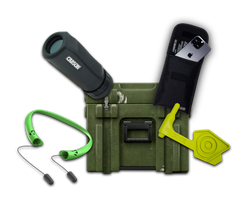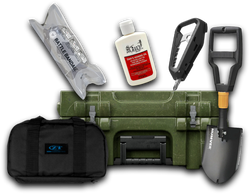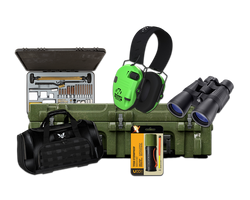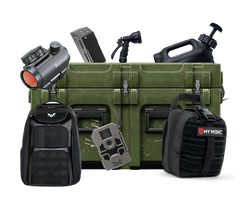How to Measure Rifle Scope Height: A Comprehensive Guide
Table of Contents
- Introduction
- Understanding Scope Height: Definition and Importance
- Methods of Measuring Scope Height
- Tools and Equipment for Accurate Measurement
- Common Mistakes in Measuring Scope Height
- Practical Applications of Scope Height Measurements
- Conclusion
- FAQ Section
Introduction
When it comes to precision shooting, the details matter. One fundamental aspect that can significantly influence your accuracy is understanding how to measure rifle scope height properly. Did you know that even a slight miscalculation in scope height can lead to unexpected misses on target? Whether you’re a seasoned marksman or a newcomer to the world of shooting, grasping the ins and outs of scope height measurement is crucial for optimizing your shooting performance.
Rifle scope height refers to the distance from the center of the scope to the center of the rifle's bore. This measurement is particularly important when entering data into ballistic calculators or adjusting your optics for long-range shooting. As the tactical community continues to evolve, so does the technology behind optics and how we engage targets.
In this blog post, we will delve deeply into the topic of how to measure rifle scope height, covering the various methods and tools available, the significance of accurate measurements, and practical applications. By the end of this guide, you will not only understand the methods of measuring scope height but also appreciate why it is vital for achieving precision in your shooting endeavors.
What You Will Learn
- The importance of measuring rifle scope height accurately
- Different methods for measuring scope height
- Tools you can use for precise measurements
- Common mistakes to avoid when measuring
- How Crate Club's products can enhance your shooting experience
Overview of Topics Covered
- Understanding Scope Height: Definition and Importance
- Methods of Measuring Scope Height
- Tools and Equipment for Accurate Measurement
- Common Mistakes in Measuring Scope Height
- Practical Applications of Scope Height Measurements
- Conclusion and Summary of Key Points
- FAQ Section
Understanding Scope Height: Definition and Importance
Before we dive into the methods of measuring scope height, it’s essential to understand what scope height actually is and why it matters. Scope height is defined as the vertical distance between the centerline of the rifle bore and the centerline of the rifle scope. This measurement is pivotal because it impacts your point of aim (POA) and point of impact (POI) when shooting.
Why is Scope Height Important?
-
Ballistic Calculations: Accurate scope height measurements are critical when using ballistic calculators. If you input incorrect values, your ballistic solutions could lead to misses, especially at longer distances.
-
Zeroing Your Scope: The relationship between your scope and bore affects how you zero your optic. Understanding this relationship allows you to make precise adjustments for elevation and windage.
-
Consistency in Shooting: The more accurately you measure scope height, the more consistent your shots will be. This consistency is crucial in competitive shooting and hunting scenarios.
-
Adjusting for Incline and Decline: When shooting at different elevations, having an accurate scope height will help you make the necessary adjustments to your aim.
Understanding these factors emphasizes the importance of measuring your rifle scope height accurately. So, let’s explore how to do that.
Methods of Measuring Scope Height
There are several methods to measure rifle scope height, each with its own advantages and considerations. Below, we’ll discuss some of the most common techniques.
1. Using Calipers
Using calipers is one of the most accurate methods for measuring scope height. Here’s how to do it:
- Step 1: Ensure your rifle is secured in a stable position to avoid movement while measuring.
- Step 2: Measure the diameter of the scope tube at the point closest to the rifle's bore. Divide this measurement by two to get the radius.
- Step 3: Measure the distance from the top of the barrel to the bottom of the scope. This measurement should be taken directly beneath the scope.
- Step 4: Measure the diameter of the barrel where the scope sits and divide that by two.
-
Step 5: Add all three measurements together. The formula looks like this:
[ \text{Scope Height} = \left( \frac{\text{Diameter of Scope}}{2} \right) + \left( \text{Distance from Barrel to Scope} \right) + \left( \frac{\text{Diameter of Barrel}}{2} \right) ]
This method provides precise results, but it requires a good set of digital calipers for accurate measurements.
2. Using a Ruler
If you don’t have calipers, a simple ruler can also suffice, although it may not be as precise:
- Step 1: Position the ruler so that one end touches the centerline of the bore (typically at the bolt face) and extend it to the center of the scope.
- Step 2: Read the measurement directly from the ruler.
This method is quick and easy but may not yield the same accuracy as using calipers, especially for fine adjustments.
3. Laser Bore Sighting Method
For those who prefer technology, using a laser bore sighter can streamline the process:
- Step 1: Insert the laser bore sighter into the muzzle of the rifle.
- Step 2: Turn on the laser and adjust your rifle so that the laser dot aligns with a marked point on the wall, like a dot or an X.
- Step 3: Measure the distance from the center of the laser dot to the center of your scope.
This method can be particularly useful for those who are already familiar with laser sighting systems and provides a dynamic way to gauge the height.
Tools and Equipment for Accurate Measurement
To achieve the best results in measuring rifle scope height, consider investing in the following tools:
-
Digital Calipers: For precise measurements, digital calipers are invaluable. They can measure internal, external, and depth dimensions, ensuring accuracy.
-
Ruler: A simple measuring tool that is widely available and easy to use for quick measurements.
-
Laser Bore Sighter: This tool helps in aligning your scope with the bore, making it easier to measure scope height.
-
Leveling Tool: This ensures that your rifle is level when taking measurements, which is crucial for accuracy.
-
Notebook or Measurement Log: Keeping a record of your measurements can help track changes in scope height when switching optics.
Common Mistakes in Measuring Scope Height
Even seasoned shooters can make mistakes when measuring scope height. Here are a few common pitfalls to avoid:
-
Not Accounting for Mount Height: Ensure that you factor in the height of the mounts or rings when calculating total scope height. This can significantly affect your measurements.
-
Inconsistent Measurement Points: Always measure from the same points (bore center to scope center) to maintain consistency across different measurements.
-
Ignoring Scope Base Angles: If using an angled base, the angle can influence the height measurement. Make sure to adjust your measurement techniques accordingly.
-
Rushing the Process: Accuracy is paramount. Take your time to ensure measurements are correct, as even a small error can lead to significant inaccuracy downrange.
-
Not Using the Right Tools: Using improper or inaccurate tools can lead to incorrect measurements. Always opt for high-quality measuring instruments.
Practical Applications of Scope Height Measurements
Understanding how to measure rifle scope height is not just an academic exercise; it has real-world implications for your shooting performance:
1. Ballistic Calculators and Software
Accurate scope height measurements are crucial when inputting data into ballistic calculators. These tools help shooters make informed decisions about holdovers, windage adjustments, and overall trajectory predictions.
2. Adjusting Your Zero
When zeroing your rifle, knowing the exact scope height allows for more precise adjustments. This is especially important in long-range shooting, where even slight deviations can result in missed shots.
3. Competitive Shooting
In competitive environments, precision is everything. Having correct measurements can be the difference between winning and losing, making scope height a critical factor in performance.
4. Hunting Scenarios
In hunting, every shot counts. By ensuring your scope height is measured accurately, you can improve your chances of making clean, ethical kills.
5. Equipment Selection
When purchasing a new scope or rifle, understanding the implications of scope height can guide you in selecting compatible equipment that works harmoniously together.
Conclusion
Measuring rifle scope height is a vital skill for any serious shooter, whether for recreational shooting, competitive environments, or hunting. With the right tools and methods, you can ensure that your measurements are precise, which in turn enhances your shooting accuracy.
By mastering the techniques and avoiding common pitfalls discussed in this guide, you’ll be well-equipped to make informed decisions regarding your optics. Remember, accurate measurements can significantly impact your shooting experience, so take the time to do it right.
At Crate Club, we understand the importance of having the right gear for your tactical endeavors. Explore our curated subscription services that provide you with high-quality tactical gear tailored to your needs. Whether you're looking for survival tools or self-defense gear, we have you covered. Visit our Crate Club Subscription Services to find the perfect plan for you, or check out our Crate Club Shop for individual products that can enhance your shooting and outdoor experiences.
FAQ Section
What is the ideal scope height for my rifle?
The ideal scope height can vary based on the type of rifle, the optics used, and personal preference. Generally, a height between 1.5 to 2.5 inches above the bore line is common, but it’s best to measure specifically for your setup.
Can I use any measuring tool to measure scope height?
While you can use various tools like rulers and calipers, digital calipers provide the most precise measurements. Always ensure that whichever tool you use is calibrated and accurate.
How often should I check my scope height?
It’s a good idea to measure your scope height whenever you change optics, mount heights, or if you experience significant shifts in your shooting accuracy.
What happens if my scope height measurement is incorrect?
An incorrect scope height measurement can lead to inaccurate ballistic calculations, resulting in misses or misjudged holdovers.
How can Crate Club help improve my shooting experience?
Crate Club offers a variety of curated tactical gear and survival tools through our subscription service, ensuring you have access to high-quality equipment that can enhance your shooting and outdoor experiences.
Share this article



